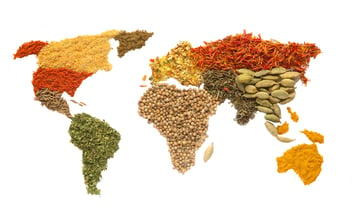Many of our customers have questions about the National Bioengineered Food Disclosure Law, which went into effect on Jan. 1, 2020 (January 1, 2021, for small food manufacturers). This blog provides answers to the top questions we have received.
General BE Disclosure Questions
Q: If the label on the ingredient I use in my product does not declare bioengineered material, is it safe to assume there are no BE materials in the ingredient?
A: As a best practice, you should not make assumptions when it comes to nutrition labeling. To ensure correct reporting, request a statement on the BE status from your supplier. If you are using Genesis R&D, we recommend that you attach any documentation you receive from your supplier to the Ingredient record.
Q: Is dairy exempt?
A: Dairy and other animal products are not exempt across the board. But, the rule says foods from animals that consumed bioengineered feed will not be considered bioengineered food products in and of themselves, so most animal products will not require disclosure. However, from the AMS:
“…if the milk contained modified genetic material from another source—such as the addition of bioengineered food ingredients—then the milk would require a bioengineered food disclosure. Similarly, if in the future a bioengineered dairy cow were approved for commercial use, then the dairy products produced by that cow would require a bioengineered food disclosure if they contained modified genetic material because the cow is bioengineered, not because of what the cow ate.”
Q: If I make a product using a small amount of an ingredient that itself may contain BE ingredients, must I declare BE?
A: If the BE is detectable, then yes, you must disclose it. For more on Detectability Testing, visit the USDA’s website.
Q: So, if even one of the ingredients in my formula contains at least one ingredient with any amount of BE material, I have to make the BE declaration.
A: Correct, unless it meets any of the exceptions:
- Restaurants
- Manufacturers under $2.5 in annual receipts
- National Organic Certified foods
- Most animal products (see question about dairy above)
- Mixed foods if meat, poultry or egg is the first ingredient or if broth, stock or water is the first ingredient and the second is meat, poultry or egg.
- Foods that contain 5% or less of inadvertent or technically unavoidable BE material per ingredient.
Q: Do you need to include both the text statement and the symbol on product packaging?
A: No. You need only to display one or the other.
BE and Non-GMO Labeling Questions
Q: Does a Non-GMO status of an ingredient or food product exempt it from a BE disclosure, even if it is derived from a BE source?
A: Products labeled as “Non-GMO” are not listed on the exceptions for BE disclosure. See the list of exceptions above.
Q: How does the BE differ from the Non-GMO project verification?
A: BE disclosure is a federally regulated requirement that will be mandatory starting Jan. 1, 2022. The Non-GMO Project is a private organization that offers verification and certification of the absence of GMO material. See our blog here on the differences.
Using Genesis R&D for BE Labeling and Disclosure
Q: How do you get the BE symbol to display on your label view?
A: On your label view page, right-click and select Show. Check Attribute Bioengineered Symbol.
Q: If you add BE attribute information and documents to Genesis R&D database items maintained by ESHA, will the items update? Will I lose my BE data? I always get a warning notice before saving and I’m not sure how it works.
A: Ingredients maintained by ESHA will save some of the user-added information (attributes, ingredient statements, etc.), but not nutrient data or the database name. You won’t lose your data from an update, but we highly recommend that you create your own ingredient using “Save As” and rename the ingredient. That way, it becomes a user-added ingredient and the data stays safe.
Q: When will the Attributes option be available in Genesis R&D?
A: This option is available in Genesis R&D Foods Version 11.7 or higher. If you do not see it, you may need to install the latest version of the software. Contact your IT department or support@esha.com for the latest version.
Additional Resources
Other posts you might be interested in
View All Posts
Supplier Compliance
4 min read
| October 11, 2019
Records FAQ on the Foreign Supplier Verification Program
Read More
Trustwell News
5 min read
| March 7, 2018
FAQ: FDA Menu Labeling
Read More
Food Industry
18 min read
| March 7, 2024

